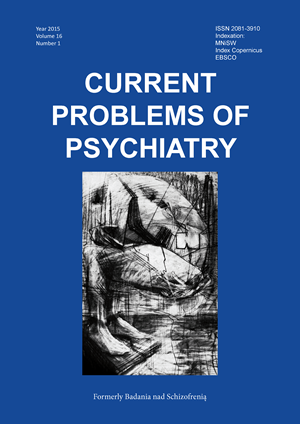Lamotrigine-induced drug reaction – case report
Keywords:
lamotrigine, pharyngitis, adverse drug reactionAbstract
Cel. Celem pracy jest opis przypadku pacjenta, u którego wystąpiła reakcja polekowa na lamotryginę, którą zgodnie ze skalą niepożądanych reakcji skórnych grupy RegiSCAR można określić jako prawdopodobny zespół DRESS (jego główne cechy to wysypka, eozynofilia i objawy układowe), powikłany występowaniem w formie rzadko opisywanych w literaturze masywnych zmian błon śluzowych jamy ustnej i gardła.
Metoda. Analiza przypadku klinicznego i dokumentacji medycznej pacjenta.
Wyniki. U pacjenta lat 52, leczonego od 4 lat z powodu ChAD typu I za pomocą kwasu walproinowego i/lub litu, po 3 tygodniach od zmiany leczenia, wystąpiła gorączka, wysypka rumieniowo-grudkowo-krwotoczna, leukopenia, limfopenia z atypowymi limfocytami, eozynofilia oraz zapalenie jamy ustnej i gardła, w odpowiedzi na wprowadzenie lamotryginy lub na interakcję lamotryginy z poprzednio dobrze tolerowanym kwasem walproinowym i kwetiapiną.
Wnioski. Masywne zapalenie jamy ustnej i gardła jest rzadko opisywanym powikłaniem stosowania lamotryginy.
Dotychczas nie znaleziono swoistych wskaźników pozwalających trafnie przewidzieć wystąpienie ciężkiej reakcji polekowej, dlatego wprowadzając kolejną substancję do terapii pacjenta musimy zachować ostrożność i oszacować potencjalne korzyści i czynniki ryzyka w trosce o jego dobro.
References
1. Lamotriginum. Charakterystyka produktu leczniczego. Urząd Rejestracji Produktów Leczniczych, Wyrobów Medycznych i Pro-duktów Biobójczych. http://www.urpl.gov.pl/drugs
2. Faught E., Morris G., Jacobson M., French J. i in. Adding lamotrigine to valproate: incidence of rash and other adverse ef-fects. Postmarketing Antiepileptic Drug Survey (PADS) Group. Epilepsia, 1999; 40(8): 1135-40.
3. Hirsch L.J., Weintraub D.B., Buchsbaum R., Spencer H.T. i in. Predictors of Lamotrigine-associated rash. Epilepsia, 2006; 47(2): 318-22.
4. Adler C.M., Fleck D.E., Brecher M., Strakowski S.M. Safety and tolerability of quetiapine in the treatment of acute mania in bipo-lar disorder. J Affect Disord, 2007; 100 Suppl 1: S15–22.
5. Vieta E., Suppes T., Eggens .I, Persson I. i in. Efficiency and safety of quetiapine in combination with lithium or divalproex for maintenance of patients with bipolar I disorder (international trial 126). J Affect Disord, 2008; 109(3): 251-63.
6. Chang L.R., Chang H.C., Lin Y.H. Quetiapine- and valproate-associated neutropenia and thrombocytopenia after lamotrigine-induced Ste-ven-Johnson syndrome. J Clin Psychopharmacol, 2012;32(1):133-4.
7. Pereira de Silva N., Piquioni P., Kochen S., Saidon P. Risk factors associated with DRESS syndrome produced by aro-matic and non-aromatic antipiletic drugs. Eur J Clin Pharmacol, 2011;67(5):463-70.
8. Saczonek A., Zdrodowska-Stefanow B. Drug hypersensitivity syndrome – odczyn polekowy z objawami układowymi. Wiad Lek, 2005; 58(5-6): 324-30.
9. Amante M.F., Filippini A.V., Cejas N., Lendoire J., Imventarza O., Parisi C. Dress syndrome and fulminant hepatic failure induced by lamotrigine. Ann Hepatol, 2009; 8(1): 75-7.
10. Roujeau J.C., Allanore L., Liss Y. Severe Cutaneous Adverse Reac-tions to drugs (SCAR): Definition, Diagnostic Criteria, Genetic Predisposition. Dermatol Sinica, 2009; 27: 203-209.
11. Taillia H., Alla P., Fournier B., Bounolleau P. i in. Anticonvulsant hypersensitivity syndrome and lamotrigine-associated anticon-vulsant hypersensitivity syndrome. Rev Neurol (Paris), 2009; 165(10): 821–857.
12. Kardaun S.H., Sidoroff A., Valeyrie-Allanore L. i in. Variability in the clinical pattern of cutaneous side-effects of drugs with sys-temic symptoms: does a DRESS syndrome really exists? Br J Dermatol, 2007; 156: 609-11.
13. Shiohara T., Inaoka M., Kano Y. Drug-induced hypersensitivity syndrome (DIHS): A reaction induced by a complex interplay among herpesviruses and antiviral and anti drug immune re-sponses. Allergol Int, 2006; 55: 1-8.
14. Kito Y., Ito T., Hashizume H, Tokura Y. High-dose intravenous immunoglobulin monotherapy for drug-induced hypersensitivity syndrome. Acta Derm Venereol, 2012; 92(1): 100-101.
15. Gomułka K., Kuliczkowska D., Cisło M., Woźniak Z., Panaszek B. Zespół nadwrażliwości indukowanej lekami - przegląd pi-śmiennictwa i opis przypadku. Pneumonol Alergol Pol, 2011; 79 (1): 52-56.
16. Renke J., Sobkowiak M., Wołowska E. Przypadki poważnych działań niepożądanych po zastosowaniu farmakoterapii i za-burzeń zachowania i snu u dzieci. Forum Med. Rodz, 2011; 5 (5): 424-428.
17. Setkowicz M., Dziunikowska A., Woroń J., Wojas-Pelc A. Lamotry-gina – lek przeciwdrgawkowy nowej generacji prawdopodobną przyczyną ostrej dermatozy polekowej – opis przypadku. Post Dermatol Alergol, 2009; XXVI, 6: 555-560.
18. McCormack M., Urban T.J., Shianna K.V., Walley N. i in. Genome-wide mapping for clinically relevant predictors of lamotrigine- and phenytoin-induced hypersensitivity reactions. Phar-macogenomics, 2012; 13(4):399-405.
19. Cheung Y.K., Cheng S.H., Chan E.J., Lo S.V. i in. HLA-B alleles associated with severe cutaneous reactions to antiepileptic drugs in Han Chinese. Epilepsia, 2013; 54(7):1307-14.


